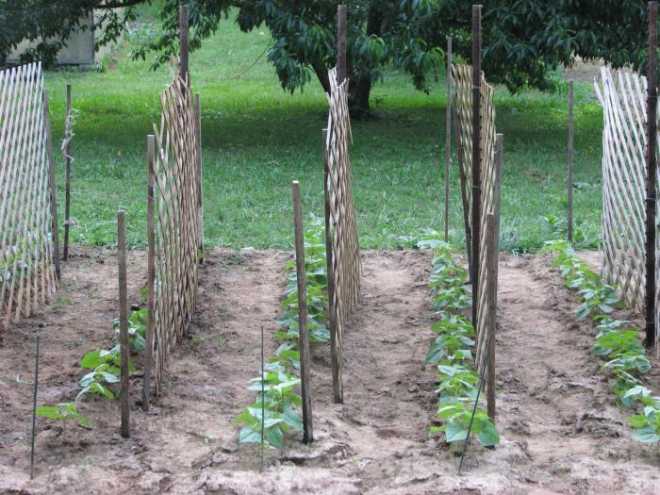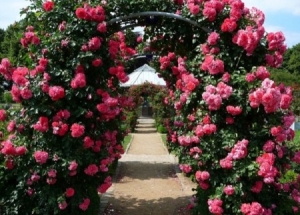Today we will talk about plants that lack trunks. It's about climbing climbing plants: clematis, grapes, cucumbers and roses. They give a kind of openwork to the garden. Yes, roses are also curly decorations, which can only be held on support. We will consider the types of these very supports in our article.
Content
- 1 Supports for Clematis
- 2 Ideas of support for clematis
- 3 How to make a support for clematis yourself, step by step master class
- 4 Supports for climbing roses
- 5 Beautiful support for roses
- 6 How to make a support for climbing roses with your own hands
- 7 Ideas of supports for climbing roses
- 8 Supporting cucumbers
- 9 Supports for cucumbers with their hands in the open ground
- 10 Supports for cucumbers in the greenhouse
- 11 How to make supports for cucumbers from corn
- 12 Support for grapes
- 13 Support scheme for grapes
- 14 How to make a prop for the grapes with their own hands step by step, master class
Supports for Clematis
- Support from the mesh netting;

- Support cylinder of plastic pipes;

- The trellis support;

- Support of the obelisk;

- Arch.

Ideas of support for clematis
Support for clematis does not have to be made according to certain standards and bought in a building supermarket. You can make it yourself, adapt unnecessary materials, for example, the remaining piece of mesh netting.

Mesh netting is quite strong and easily molded material. From it you can make figures that will later decorate the garden, or fix it as a wall-mount for a climbing plant.

The second material after the galvanized mesh is usually wooden structures, constructed from the remaining building materials: laths, racks, pegs.

And, finally, the most popular solution is to put clematis on the walls. The climbing plant clings to its shoots for any protruding section. So the inhabitants of private farmsteads often plant clematis on inter-judicial partitions separating personal territory from the neighbor.

A win-win option for planting clematis is the porch of the house and its walls. Columns and railings will become a strong support for the branched perennial.

The wattling plant will look harmonious in the pots exposed near the house. Sometimes it is replaced by grapes, which also surrounds the space with a green crown.

How to make a support for clematis yourself, step by step master class
One of the simplest supports for clematis, as well as for other woven plants, is the support of wooden slats. A dozen trellis is enough for the construction of a perennial flower garden. In advance, think at what height you would like to contemplate the curling flowers. 2-3 m will be enough.

Prepare the slats to form the support, take care of the form. Below is an example of designs. The choice is made based on free space or "places" that need to be documented.

The most primitive design of the trellis is a rectangular or square shape. Stock up with screws, screwdrivers, clamps and slats. Lay out a rectangle of the correct size in the free space, fasten the straps with clamps to avoid displacement. Then fix them together with screws.

Now, starting from the bottom right corner, overlay the diagonal slats. Fasten them with screws on the frame of the rectangle. The pitch frequency between the rails is usually 20-25 cm. Once you are finished with the parallel, turn the shape and fix the diagonal purl strips.

Crossing of the pillars of the support is additionally fastened by means of self-tapping screws. So that each rhombus has a fixation opposite each corner.

After the clematis support is ready by hand, it is treated with antiseptic, covered with varnish or paint. Tapestry set on the planned location and well strengthened at the base. For this, metal corners are used that fix the structure.

video: self-clematis support
Supports for climbing roses
- Suspended support. Usually, such a support is a porch, window awnings, canopies of the gate;

- The support is a wall. Often the trellised support is exposed as a separator of the garden space;

- Fence. A bright flower bed fill all the gaps of the fence;

- Self-made support. The shape of the structure is absolutely anything, the main thing is that it will withstand the weight of a rapidly growing flower garden;

- Support the cone. A design that is quickly erected manually or sold in supermarkets in an already finished form.

Beautiful support for roses
- The walls of the house. Not only the garden, but also the walls of the house will be suitable for placing a rosary. A few planted bushes decorate the space in the corners of the house, between the windows, the roof;

- Balcony. Climbing roses decorate the balcony of the apartment or the balcony of a private house. Even if the structure needs repair, its main decoration will be beautiful roses;

- Arch. A magnificent hedge will look harmoniously at the entrance to the gates, into the garden or as a separate decorative element of the infield;

- Support palm-pillar. The blossoming pedestal, like a fragrant oasis, will decorate any corner of the garden space;

- Static support. Looks like a stand. The flowering plantation will grow "flow" with its bright buds and decorate the garden as it grows.

How to make a support for climbing roses with your own hands
Turning your garden into an oasis can be literally within the first year of its formation. Rose is recognized as queen of the garden. Scrofulous rosaceous will add to your park also a riddle. For bright buds you can hide the flaws in the buildings and emphasize their advantageous sides. Any modest place will turn into a blossoming oasis. Strong supports are needed to fasten the plants. On them the rose will grow and transform the garden.

The support for a beautiful rose can do it yourself. Surely, you have on the site there are several metal rods or wooden stakes, from which will come out a reliable fastening. Before the construction of such a structure, it is worth considering that each plantation reaches a length of approximately 4 m. Accordingly, as the flower grows, its weight also increases, so the trellis for rosaceous should be strong.
The most primitive version of the support for clinging roses is a spacer made of wooden slats, decorated and fastened in the form of beams. Initially, to build a support in the ground you need to dig a wooden pole, for reliability it is better to concrete it.

Next to the pole is mounted the support itself. On it you need about 8-10 racks. Lay the slats in the form of a fan. From the base in steps of 30 -40 cm, fix them with slats.

Parallel fasteners are mounted with nails, glue or screws. Choose the most appropriate method. If you do not have neither one nor the other, then use pieces of aluminum wire. Twist it to the intersection of the support and thus secure the parts. The finished structure is screwed to the pole along the central bar.

Ideas of supports for climbing roses
- The support of the pergola. It is an arch or canopy, simultaneously giving a shadow and a place for plant growth;

- Tapestry. Stand support of various variations in width and height;

- Support the wheel. The wider the diameter, the more space for the plant.

Supporting cucumbers
- Bicycle wheels and twine;

- A trellis net for growing cucumbers;

- Frame made of wooden slats and twine.
Supports for cucumbers with their hands in the open ground
- Support "wigwam" for cucumbers with their own hands from the net and metal rods;

- Support for cucumbers with their own hands - metal barrel;

- Metal mesh for own hands for cucumbers.

Supports for cucumbers in the greenhouse
- Support wooden grid + twine;

- Support vertical twine;

- Mesh galvanized.

How to make supports for cucumbers from corn
It turns out that corn and cucumbers are very friendly plants, despite the significant difference in the yield of fruits. Corn, as we know, stretches up and grows like a green pillar. Cucumbers, on the contrary, spread along the ground, forming lace plantings. This is exactly what we need.

During intensive growth, corn lengthens in the stem. At one time, simultaneously planted cucumbers will cling to leaves of cereal crops. It is important to plant cucumbers at one time with corn kernels. And the planting should be carried out along rows, alternating plants (cucumber-corn) at a distance of not less than 20 cm.

If you plant cucumbers closer to the corn, the cucumber stems will develop much worse. Despite the fact that the roots of corn go much deeper than cucumber, the close location of pumpkin to the roots of cereals will not give full development. However, if all conditions are met, both crops will have an excellent harvest. As soon as cucumbers begin to appear antennae, direct them to the support - the neighboring corn.

During the joint growth of corn, the cucumber leaves will pritenet, not allowing them to scorch under the sun's rays. In addition, cucumbers will be protected from parasites until the end of the growing season. Thus, being on top, cucumber strands will bring a hassle-free crop, for which you do not need to bend over.

Support for grapes
- Support for grapes - a gazebo;

- Support for grapes - shed;

- Tapestry under the grapes of plastic.

Support scheme for grapes
The most common variant of the support for the grapes is an arched canopy. In the summer time, this canopy saves from the heat. Sprawling grapes cover the gaps between the trellises, and the fruit-bearing brushes dangle in the intervals between the rows.

How to make a prop for the grapes with their own hands step by step, master class
Before installing the support for grapes, it is necessary to choose the site where the vineyard is planned to be placed for many years. The support should extend clearly from north to south. Growing in this arrangement, the grapes will receive the maximum amount of sunlight so necessary for the maturity of the crop.

The quality of the crop depends on the reliability of the structure. With each passing year the vine becomes stronger, and the grape clusters are larger, correspondingly, the load on the support increases. Consider the scheme of the vineyard. We offer for consideration a one-plane scheme.

Metal or concrete poles, perhaps, this is the first material that you need to take care of. Depending on the height of the structure, the ground depth of the support will depend. For example, in our case, a well of 50 cm will be sufficient for a 1.6 m support. With the growth of the vineyard, the load on the poles will increase. The posts are installed along the entire length of the support with an interval of 2-2.5 m. Further after the installation of the poles, metal strings or twine are pulled, for which the grapes will cling. To place them it is necessary in several rows with a step of 30-40 cm. Vine lashes with growth should be corrected and directed to the support frame.

There are other supporting structures, which can also be built independently. They can differ in the number of planes, the quality of the material, the size and other parameters. As for grapes, and for cucumbers, climbing roses, choose the sites that are suitable for your zoning. Success and pleasant hassle in your garden plot!



















